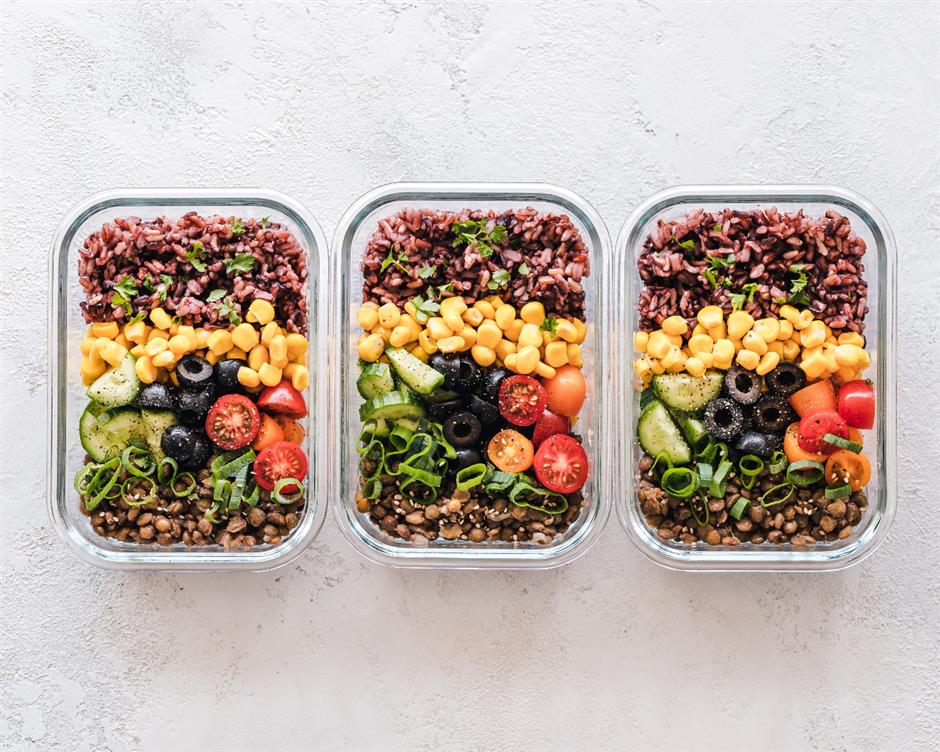
There is no one-size-fits-all approach to what you should eat, when to eat, or how to eat. That’s why your WAG nutrition coach provides you with personalized tips on how to build your day of eating, with your needs in mind.
Even with those guidelines, we understand that figuring out a method that works for you can be hard, so we’re sharing our universal tips to approach meal planning that can work for almost any level of health and fitness needs.
Set a Schedule
Decide how many times per day you’d like to eat or can reasonably fit in a meal/snack. This helps you anticipate how many opportunities you have to eat throughout the day and makes it easier to pace your intake. If your schedule is irregular, you can create templates to follow on specific days of the week. For example, if you know that Tuesdays and Thursdays bring back-to-back classes followed by a quick car ride to work, then it’s reasonable to assume that you probably can’t follow a six-meal-a-day plan on these days. Find ways to adjust your schedule to compensate.
Divide and Conquer
Once you determine how many meals you can or would like to eat each day, divide your total macro targets.
This gives you a guideline of how much of each macro you should eat per meal to evenly space it throughout the day. This is a great tool if you find yourself under or over one macro on a consistent basis since it promotes including an appropriate balance of each macro at each meal.
Advertisement
For example: 200 C / 45 F / 145 P split between five meals per day = 40 C / 9 F / 29 P per meal.
Once you have made that determination, you can begin tweaking and planning how you will structure your meals to account for nutrient timing around your workouts. Keep in mind that we want to set a strong foundation first. Building consistency with your intake will have more of an impact than meal timing, so try sticking to the basics before worrying about more nuanced details.
The example below is based on four meals per day, but you can divide up the macros outside of the pre-and post-workout meals however you’d like. We still recommend prioritizing carbohydrate and lean protein intake around training to help fuel your body for energy and recovery, so we suggest not moving those macros around too much.
- Breakfast – 25% of protein / 20% of carbs / 35% of fats
- Pre-workout – 25% of protein / 30% of carbs / 15% of fats
- Training session post-workout – 25% of protein / 30% of carbs / 15% of fats
- Dinner – 25% of protein / 20% of carbs / 35% of fats
We get that your busy schedule might mean a training session early in the morning or late at night. If that’s the case, you may benefit from our blog post on nutrient timing for workouts.
Taking It Day by Day
If you value variety in your food and eating the same thing each day doesn’t appeal to you, that’s okay too! You can make meal plans just for each day based on your preferences at the time.
Advertisement
Put your preferred foods in MyFitnessPal ahead of time (the night before or in the morning) so you can see how close you will get to your daily macro goals. Then go back and either adjust portions on different foods to round out your macros or add in another little snack—boom!
Remember, these are just tips for getting started—as you experiment with different strategies for eating, you can always adjust your plan based on what works and what doesn’t.
If you’ve got the timing down and are hitting your macros every day but still find yourself in a state of constant hunger, you may want to consider these strategies for eating to actually feel full. Or, consider hiring a nutrition coach who can help plan your meals based on your needs and preferences.
Schedule a Free Intro Call
Working Against Gravity has led the macro tracking and health space for over a decade. Our team doesn’t just understand the science of nutrition—we’ve spent years mastering the art of tailoring it to fit your life. That means no cookie-cutter plans, just real strategies that have worked for over 30,000 people.
Schedule a free call with our team to learn how working with a 1-on-1 WAG coach will help you reach your goals.



